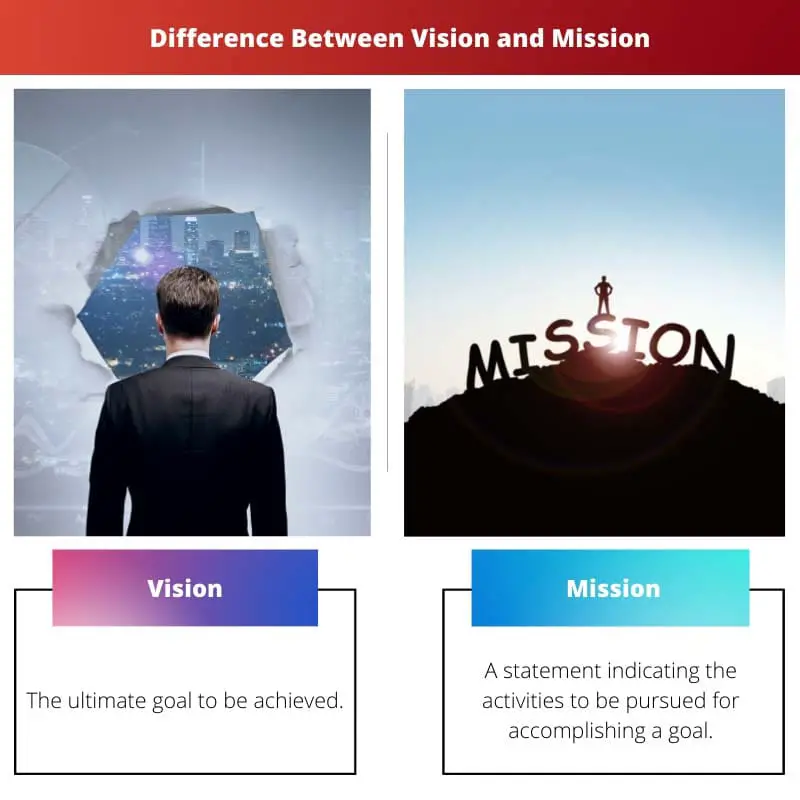Vision: A succinct statement of an organization’s future aspirations or desired state. Mission: A concise declaration of an organization’s purpose, outlining its activities and the impact it seeks to make.
Key Takeaways
- A vision statement defines an organization’s long-term aspirations and desired future state, providing inspiration and guidance for strategic decision-making and goal-setting.
- A mission statement outlines the organization’s core purpose, objectives, and approach to achieving its goals, serving as a practical guide for daily operations and decision-making.
- While both vision and mission statements are essential for organizational direction, the vision statement focuses on future aspirations, and the mission statement details the organization’s present activities and purpose.
Vision vs Mission
The word “vision” describes a concept or imagined mental representation of something. For example, she had a vision of a future with world peace. While “mission” refers to any significant task that someone is assigned to complete or any work that they feel is their obligation to complete.

However, the above is not the only difference. A comparison between both the terms on certain parameters can shed light on subtle aspects:
Comparison Table
| Feature | Vision | Mission |
|---|---|---|
| Focus | Future: Where the organization aspires to be | Present: What the organization does and why |
| Timeframe | Long-term: Years or even decades | Short-term: Ongoing and achievable |
| Specificity | Broad and inspirational | Clear and action-oriented |
| Emotion | Evokes passion, excitement, and motivation | Creates meaning and purpose |
| Audience | Primarily internal (employees, stakeholders) | Both internal and external (public, customers) |
| Examples | “To be the leading provider of sustainable energy solutions” | “To empower communities through education and job creation” |
| Relationship | The “what” the organization will achieve to fulfill its mission | The “why” the organization exists and its core values |
What is Vision?
A vision statement is a forward-looking, aspirational declaration that outlines an organization’s long-term goals, aspirations, and desired future state. It encapsulates the organization’s fundamental reason for existence and serves as a guiding beacon for strategic decision-making and goal-setting. A well-crafted vision statement paints a vivid picture of what success looks like for the organization, inspiring stakeholders and rallying them around a common purpose.
Key characteristics of an effective vision statement include:
- Inspirational: A compelling vision statement should inspire and motivate stakeholders, capturing their imagination and igniting their passion for achieving the organization’s goals.
- Future-oriented: Vision statements focus on the future, articulating where the organization aspires to be in the long term. They describe a desired future state that the organization aims to create or achieve.
- Clear and concise: A good vision statement is clear, concise, and easily understandable by all stakeholders. It avoids jargon and ambiguity, making it accessible and memorable.
- Ambitious yet attainable: While vision statements should be ambitious and stretch the organization to achieve its full potential, they should also be grounded in reality and achievable with effort and commitment.
- Reflective of values and purpose: Vision statements should reflect the organization’s core values, beliefs, and purpose. They communicate what the organization stands for and what it aspires to contribute to society.
- Forward-looking and adaptable: As the external environment evolves and circumstances change, vision statements should remain relevant and adaptable. They should guide the organization through periods of change and transformation, providing a stable foundation amid uncertainty.

What is Mission?
A mission statement is a comprehensive declaration of an organization’s fundamental purpose, defining why it exists and what it seeks to achieve. It encapsulates the core values, goals, and activities of the organization, providing a clear sense of direction and guiding principles for decision-making and action. A well-crafted mission statement addresses several key components:
- Purpose: It articulates the reason for the organization’s existence, answering questions like “What do we do?” and “Why do we do it?” This helps stakeholders understand the underlying motivation and drive behind the organization’s actions.
- Values: It reflects the fundamental beliefs and principles that guide the organization’s behavior and decision-making processes. These values serve as the moral compass, influencing the organization’s culture, priorities, and relationships with stakeholders.
- Goals/Objectives: It outlines the specific outcomes or achievements the organization aims to accomplish in pursuit of its purpose. These goals provide clarity and direction, helping to focus efforts and resources on activities that contribute to the organization’s mission.
- Target Audience/Beneficiaries: It identifies the primary beneficiaries or target audience for the organization’s products, services, or activities. Understanding the needs and interests of these stakeholders is crucial for aligning the mission with their expectations and requirements.
- Scope/Activities: It describes the scope of the organization’s operations and the range of activities it engages in to fulfill its mission. This can include the products or services offered, geographic locations served, and key areas of focus or expertise.
- Differentiation: It highlights what sets the organization apart from others in its field or industry, emphasizing its unique strengths, capabilities, or approaches. This differentiation helps to position the organization effectively and attract support from stakeholders.

Main Differences Between Vision and Mission
- Vision:
- Describes the desired future state or long-term aspirations of the organization.
- Focuses on where the organization aims to be or what it hopes to achieve in the distant future.
- Provides a broad, inspirational outlook that guides strategic planning and decision-making.
- Often timeless and enduring, remaining relevant even as goals and strategies evolve.
- Inspires and motivates stakeholders by painting a compelling picture of the organization’s ultimate purpose.
- Mission:
- Articulates the fundamental purpose and reason for the organization’s existence.
- Defines what the organization does, who it serves, and how it achieves its objectives.
- Provides a clear statement of the organization’s activities, goals, and values.
- Typically more specific and actionable than a vision statement, focusing on the present and near future.
- Guides day-to-day operations, strategic initiatives, and resource allocation decisions.
- Reflects the organization’s core identity and serves as a foundation for building its brand and reputation.





